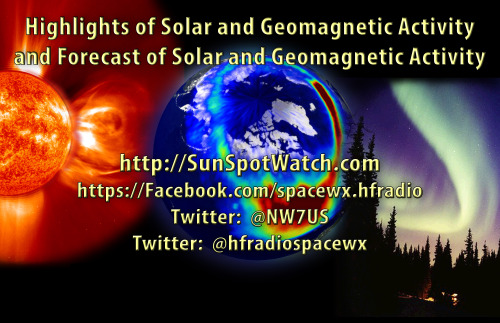The NW7US Beacon
RSS
Here is this week’s space weather and geophysical report, issued 2015 Nov 16 0630 UTC.
Highlights of Solar and Geomagnetic Activity 09 - 15 November 2015
Solar activity was at very low to moderate levels over the period. The period began at moderate levels with an M3/2b flare at 09/1312 UTC from Region 2449 (S12, L=207, class/area Dao/150 on 08 Nov). Associated with the flare were Type II (957 km/s) and Type IV radio sweeps, a 670 sfu Tenflare, and a partial halo coronal mass ejection (CME). Originally, the CME was thought to have a partial Earth-directed component; however, there was no arrival apparent in ACE/SWEPAM data. Low levels were observed on 10 and 13 November due to low level C-flare activity from Regions 2443 (N07, L=316, class/area Fkc/650 on 01 Nov) and 2452 (S08, L=169, class/area Axx/010 on 11 Nov). Late on 15 November, two filament eruptions occurred in the SW quadrant. The first was an approximate 21 degree filament eruption centered near S11W17 that was observed lifting off around 15/2114 UTC in SDO/AIA 304 imagery. The second was an approximate 19 degree filament eruption centered near S26W24 observed lifting off around 16/0114 UTC. Analysis was ongoing for these two events, however given their location and initial trajectory, an Earth-directed component is probable.
An enhancement (below S1-Minor threshold) of the greater than 10 MeV proton flux occurred at 09/2130 UTC associated with the M3 flare. Particle flux measurements reached a maximum of 3.7 pfu 10/0020 UTC before declining to background levels by early on 11 November.
The greater than 2 MeV electron flux at geosynchronous orbit was at high to very high levels over the period. Very high levels occurred on 11 and 13 November with maximum flux levels of 59,508 pfu at 11/1915 UTC and 88,813 pfu at 13/1355 UTC, respectively.
Geomagnetic field activity ranged from quiet to major storm levels. The period began under the influence of a prolonged negative Bz component followed by a solar sector boundary crossing mid-day on 09 November. Shortly after, a co-rotating interaction region preceding a positive polarity coronal hole high speed stream (CH HSS) became geoeffective starting in the latter half of 09 November. Total field rose briefly to 12 nT with solar wind speeds increasing to the 650-750 km/s range. Solar wind continued to be enhanced through 12 November as CH HSS effects declined. The geomagnetic field responded with unsettled to (G1-minor) minor storm levels on 09 November, active to (G2-moderate) major storm levels on 10 November, and quiet to minor storm levels on 11 November. Quiet levels were observed on 12 November. By 13 November, another positive polarity CH HSS became geoeffective causing total field to initially rise to 10 nT with solar wind speeds in the upper 400 km/s range. Total field remained slightly agitated from 14-15 November with total field ranging from 5-9 nT. As a result, quiet to active levels were observed on 13 November, with quiet to unsettled levels on 14-15 November.
Forecast of Solar and Geomagnetic Activity 16 November - 12 December 2015
Solar activity is expected to be at very low to low levels with a chance for M-class (R1-R2, minor-moderate) flares from 22 November through 05 December with the return of old Region 2443 (N07, L=316).
No proton events are expected at geosynchronous orbit.
The greater than 2 MeV electron flux at geosynchronous orbit is expected to be at high levels from 16-18 November and again from 01-12 December due to recurrent CH HSS influence. Normal to moderate levels are expected from 19-30 November.
Geomagnetic field activity is expected to be at unsettled to active levels from 16-19 November due to prolonged southward Bz as well as a negative polarity CH HSS on 18-19 November. Multiple recurrent positive polarity CH HSSs are expected to influence the geomagnetic field from 30 November-02 December, 05-08 December, and 10-12 December causing unsettled to active levels with (G1-minor) storm periods likely on 30 November-01 December, and 06-08 December.
The eruptive filaments on 15-16 November are not in the present forecast as we are waiting on further imagery to model these events.
Don’t forget to visit our live space weather and radio propagation web site, at: http://SunSpotWatch.com/
Live Aurora mapping is at http://aurora.sunspotwatch.com/
If you are on Twitter, please follow these two users: + https://Twitter.com/NW7US + https://Twitter.com/hfradiospacewx
Get the space weather and radio propagation self-study course, today. Visit http://sunspotwatch.com/swc/ for the latest sale and for more information!
Check out the stunning view of our Sun in action, as seen during the last five years with the Solar Dynamics Observatory (SDO): https://www.youtube.com/watch?v=zXN-MdoGM9g
We’re on Facebook: http://NW7US.us/swhfr
